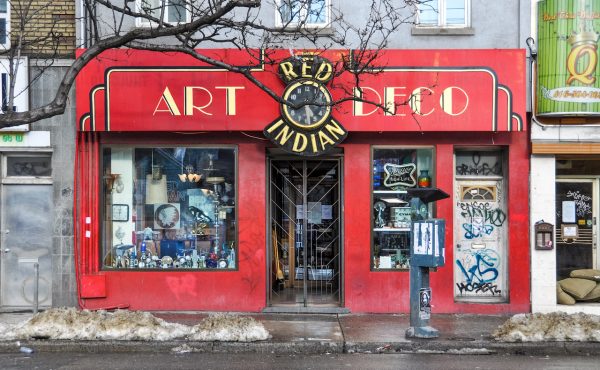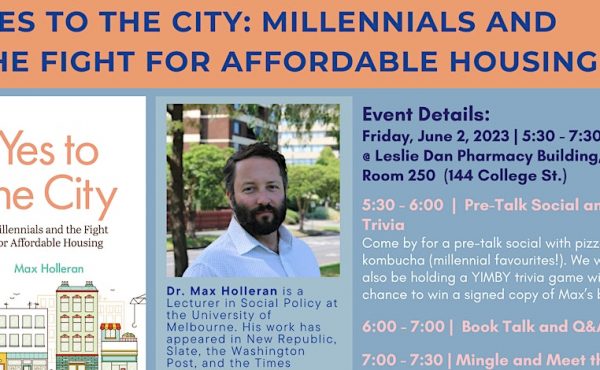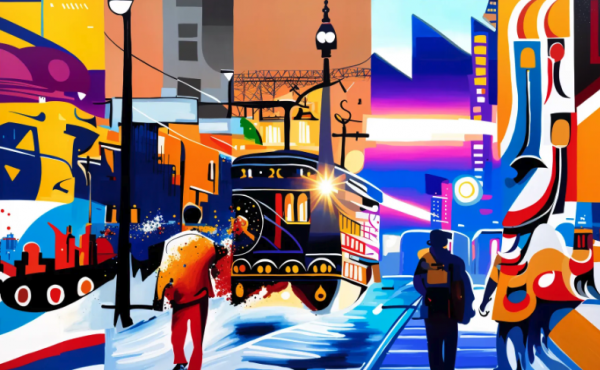 On Sunday Coach House Books is launching the second volume of uTOpia, this time called “The State of the Arts: Living with Culture in Toronto” at the Gladstone Hotel. Three Spacing editors have essays in the book, as do a number of folks who have contributed articles to past issues.
On Sunday Coach House Books is launching the second volume of uTOpia, this time called “The State of the Arts: Living with Culture in Toronto” at the Gladstone Hotel. Three Spacing editors have essays in the book, as do a number of folks who have contributed articles to past issues.
The State of the Arts explores the Toronto arts scene from every angle. The essays consider the big-ticket and the ticket-free, from the Opera House and the CNE to the accidental art of graffiti eradification and under-ground hip-hop. In between, you’ll find considerations of art in the suburbs, how business uses the arts to sell condos, questions of arts infrastructure, a consideration of Toronto on film and a history of small press publishing. You’ll read about the fine line between party and art, the trials of being a capitalist in a sea of hippie artists, the power of the internet to create arts communities and a plea for venues that cater to musicians and their kids.
Sunday, November 26, 2006
Gladstone Hotel Ballroom (1214 Queen St. W.)
$5 / free with the purchase of a book
co-presented with Pages’ This Is Not a Reading SeriesDoors open at 2 p.m.
3:00 p.m. — Panels
moderated by Misha GloubermanUnofficial Culture: Karen Hines, Sarah B. Hood, John Lorinc, Stuart Ross and Carl Wilson.
Official Culture: Jason Anderson, Kat Collins, Natalie De Vito, Dylan Reid and RM Vaughan.
7:00 p.m. — Music
co-presented with WavelengthThe Phonemes, More Or Les and Scarborough A/V.
We’ve been told Scarborough A/V is actually all about Scarborough, and visuals of that noble borough will be part of the show.




12 comments
I haven’t decided whether I want to go. I’d probably know a lot of people there (I certainly know enough of the contributors), but for a variety of reasons, I had a really bad time at the launch of the last one.
One of the things that irritated me was that the book seemed to be introduced and marketed as a broad and rather definitive survey of opinions about Toronto’s present, and visions for its future, and yet I’m not sure if there was a single contributor to the volume who was not white.
While the new one seems to be a little better in this regard, I’m wondering whether anyone can tell me how many of the thirty-five writers are (or identify as) persons of colour? I don’t mean this to sound facetious – I am genuinely curious as to whether the editors addressed what was arguably a serious weakness of (and oft-express concern about) the first book.
I must confess, however, that the few parts of uTOpia I have read I did not find nearly as entertaining as Joe Clark’s hilarious chapter-by-chapter breakdown: leslieville.org/spacing/utopia
While I certainly differ from Clark on many of his assessments of individual chapters, I agree with his broader point: uTOpia was a heartfelt expression of “My Toronto Ends at Dupont” mythmaking. Of course, Joe, being a proud east-sider, expresses this concern mostly in terms of the east-west discrepancy; being a North Yorker (who grew up in North Toronto) myself, I am more conscious of the fact that the book’s boundaries of Toronto seem to conclude far south of even where the former municipality of Toronto left off (along Yonge, the Old City of Toronto extended almost to York Mills, and yet in the book the New City of Toronto barely seems to stretch beyond Bloor). uTOpia tried to address this with John Lorinc’s “Stripping Away Stereotypes: Toronto’s Retail Plazas,” but as much as I love John, I found the piece (or at least the version published in Now Magazine) to be rather, well, ethnographic.
A fine lineup of writers (though the cover doesn’t look as good as the first one). Enjoy the launch (and go early, if last year’s crowds are any indication of this year’s) – and ask questions after the readings. Nothing worse than hearing crickets and seeing tumbleweeds after a reading, especially of stuff like this.
Sorry I won’t be able to be there.
But how much is the book then?
Jonathan> Bad time at the last launch or not, I don’t think anybody was under the impression that the first uTOpia was a “definitive survey” of Toronto. I certainly wasn’t. Some of the reviewers or chatter about it after it was published may have said or eluded to this, but that’s the way it goes when something is floated publicly. The editors were fairly forthcoming in saying it was an experiement to see what would happen if they did an open call for ideas, casting a wide net, without any grand theme.
People can write about what they want to write about, and if it’s about their neighbourhood where they live, so be it. People from other neighbourhoods are as free to contribute their ideas about those neighbourhoods as anyone else. I’m certain the editors didn’t reject ideas because they weren’t downtown. I’m personally a little more interested in the places outside the downtown core, so I often write about or explore these places, but other people cast their gaze more locally, and shouldn’t feel guilty about that. If people want more outside stuff, nothing is prohibiting them from contributing.
As for the whiteness of the contributors, I’m not sure how this is the “fault” of editors who put out an open call for submissions. It could be a wider criticism of the background of people involved or passionate about urban-ish things, a scene uTOpia is tapping. I think given time, like every field in Canada, this will change as second generation folks get involved.
Given the overall cultural context behind uTOpia, I suppose even the likes of Councillor Rob Ford could count as a euphemistic “person of colour”…
The excerpts I’ve seen of The State of the Arts (and yes, I’m one of the cast of dozens of contributors) seem thoughtful and wide-ranging and, better yet, strike me as invitations to collaborate in making and interpreting and dis/agreeing about the city’s art and culture. I’ll add that praise and criticism leveled at both books underscore the great need for them: one of the most important successes of the uTOpia volumes is that they’ve given people something to rebel against. The series has, perhaps for the first time, tried to articulate in book form aspects of the city’s form and character that matter to the people living here. Is it incomplete? Of course! Disagree with something or see yourself not represented? Then write about it yourself — that’s exactly what the call for submissions for the uTOpia volume asked for.
A year ago, when the Imagining Toronto project was taking its first fumbling steps, I read Bert Archer’s essay claiming that Toronto doesn’t exist in the imagination, published in the first uTOpia book. I took Bert’s claim (which I disagree with) as an important point of departure for my own work, and for my own contribution to the second volume, an essay called “Toronto’s Tower of Babel”.
uTOpia volume 1 and The State of the Arts aren’t the only new books celebrating culture in Toronto. If you’re interested in other voices, you should also check out TOK: Writing the New Toronto (presented by Diaspora Dialogues and released just this fall) and T-Dot Griots: An Anthology of Toronto’s Black Storytellers (2004).
I forgot to add that the list of contributors to the new anthology is pretty diverse: it’s certainly not only ‘white people of privilege’ who’ve written the essays. Such a category is itself problematic, given that people self-identify in diverse ways according to gender, race, ability, sexual orientation, etc.
Any way to see a table of contents for the book? The authors list looks great, but a list of chapter titles would give a better sense of what’s in there. I haven’t been able to find one online, and won’t be living in Toronto for another six months — so can’t come.
Re ALH’s self-identification comment: thus my ref to Rob Ford as “person of colour”–more so than, say, Desmond Cole.
Maybe, to reflect upon my own EE-ethnicity inside-talk, it’s like the sophisticates vs the bohunks?
For that matter, it’s all reminding me of the quibble I voiced, back at the first uTOpia launch, with Erik Rutherford’s lionization of Paris–raising the then-recent race riots to make my point. So once again, to go all Parisian, it may depend on what side of the Peripherique you reside…
Mmph. At risk of opening further controversy, I’m going to suggest that the problem here is more with the phrase “person of colour” than reflecting some fundamental problem with self-identification. Ford may look white to you, but to me he looks like someone with what used to be called a ‘glandular problem’, and I’d say that’s as valid a criterion of difference as any other.
The difficulty with categories, especially of race and gender, is that they intersect with socio-economic class and privilege. On these latter grounds, it wouldn’t appear that someone like Ford could claim to have experienced much marginalization or discrimination. But at the same time, I don’t think that a South Asian Web 2.0 entrepreneur stepping over a homeless schizophrenic who has wandered in from Wawa to perch on a grating at King and Bay has much of a claim either.
On those grounds, I don’t think it necessarily accomplishes much to ask how many “persons of colour” contributed to uTOpia or any other single anthology, unless there’s an openness to asking the other questions that must necessarily go along with the first one. Such as: Where are the voices of the working class? Are there any contributors who do not have university degrees? Where’s the story about the cat lady who lives just off Lansdowne, or the reclusive St. Jamestown artist whose mummified body was discovered six months after his death? Who’s speaking for guys holed up in the Metro West detention centre or the halfway house on Keele? Who’s writing on behalf of ten thousand suburban housewives who’ll never be able to pick up a copy of The Feminine Mystique because they can’t find parking at the mall?
And if you answer that you can’t fit all these voices into a single anthology, I’ll agree with you. And then I’ll paraphrase Toronto novelist and poet Dionne Brand, who commented a year or so ago that Toronto is a city still catching up with its new stories. What’s a diverse city to do? Maybe get out there and write about some of them.
I think we need a SSHRC grant to sort this out.
Heh. Or a third volume in the uTOpia series.